
We start with an outline of definite integral for functions of one variable that is not formally correct but conveys the right idea. The expression

Now we extend this idea to functions of more variables. If we have some
set Ω in
![]() we can
imagine a superthin cylinder of height
we can
imagine a superthin cylinder of height
![]() )
)
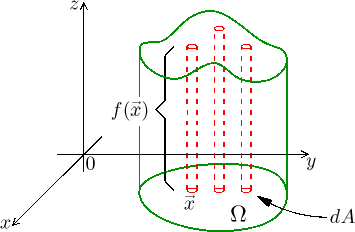
If we "add" their volumes -- which are obviously
![]() )⋅dA,
)⋅dA,
![]()
This is called the double integral. Its meaning is intuitively clear,
it is the volume of the solid whose base is Ω and its top part
coincides with the graph of the function f. Just like in case of one
variable, also here the volumes are subtracted when
![]() ) < 0,
) < 0,
We readily generalize this idea of double integral to functions of even more variables, for instance
![]()
is the four-dimensional size of the object "under" the graph of a function
f
of three variables. Since such a function takes its variable from the space
![]() from the given
set Ω.
from the given
set Ω.
Remark.
Sidenote on terminology: In mathematical analysis, "region" is a special
term describing a set that is connected and open. Unfortunately, when it
comes to integration, people traditionally use the word region for the set
over which we integrate, regardless of its properties. While we usually do
integrate over connected sets, they are rarely open, in fact, in most cases
the set Ω is closed.
This is unfortunate, but the word "region"
somehow fits with the whole integration picture and pretty much everybody
uses it. I tried to use "set" instead so that this text is precise, but
somehow "region" sneaked in anyway, so I left it here. Please be aware
that in this particular chapter region does not mean a mathematical region,
in particular it need not be open, it is just another word for a set.
The main idea of a more-dimensional integral seems clear, but it is not obvious how one would go about actually calculating such an integral. We will try our favourite trick and introduce slices, which turns the problem into a one-dimensional affair. We will arrive at cuts in axial directions by organizing "columns" smartly.
As usual we first look at functions of two variables. There we will utilize
the idea that we add superthin rectangular boxes whose bases
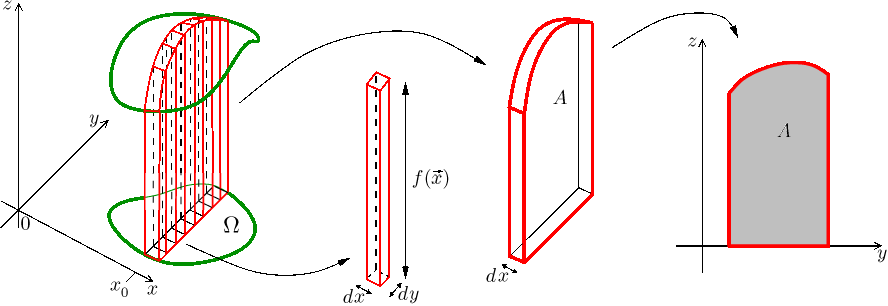
That side area, the slice through the graph of f, can be easily
determined; it is the area under the graph of the function
We will now try it again, but with some mathematics. If we choose
So for a chosen
![]()
which is the two-dimensional area of the slice through the solid under the graph of f.
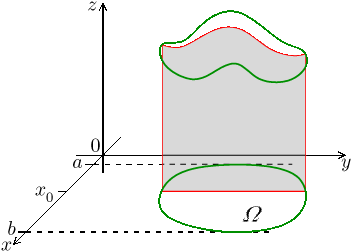
To make things practical we just pretend that x is a constant and integrate with respect to y. It is the same idea as with partial differentiation, so it should not cause much trouble. Note that we obtain a number that depends on the choice of x, but the variable y gets used up during integration.
If we multiply this area by the "thickness"![]()
which is the volume of the slice as a three-dimensional object that we obtained above by organizing the thin rectangular columns.
We get other slices by changing the fixed value x. To include the whole volume of the solid, we need to "add" volumes of individual slices, which we will obviously do by integration using x. It all nicely fits together, as we already observed that volumes of slices depend exactly on the choice of x. The least value a and the largest value b for x are determined by which slices through Ω are non-empty. We get the formula
![]()
In order for this whole thing to work, the set
Ω must be shaped in
such a way that we are able to find the functions
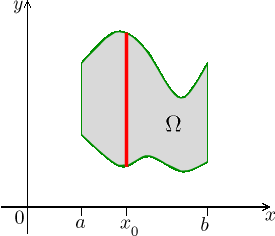
Then
![]()
Such a reworking of a double integral is called a repeated integral.
It is good to learn how to rewrite such an integral just using a picture of Ω, without referring to the graph of the function (which needs an extra dimension). We want to use a double integral to pass through all points of the set Ω. We decided to go through them via segments parallel to the y-axis, in our picture above it means vertical slices. The inner integral runs over a typical slice whose endpoints obviously depend on the location of this particular slice, that is, on x. Using the outside integral we then run through all the slices by changing x.
As one can expect, it is not necessary to start cutting in the y-direction. The set Ω could be oriented the other way,

that is, the set could be of the form
![]()
This is the second possible expression for a double integral.
Some sets fit with both specifications, then we can choose in which direction to cut.
Example.
We will integrate the function
We have a choice which variable to use for the first integration, because in a rectangle slicing in both directions works. If we want to integrate with y first, that is, to fix x and slice in the y-direction, then y changes between 1 and 3 regardless of the slice's position.
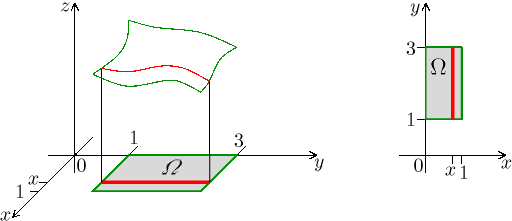
The picture on the left is just symbolic, the graph most likely looks differently, it is there only to remind us of the general situation. We are more interested in the picture on the right, we should be able to deduce all necessary information from it.
For the integral over one slice we get

where x is taken as a constant. Then also

As we expected, the variable y disappeared and the "area" of the slice depends only on its position given by the value of x. Now we "add" these slices (integrals) using x, we get

Some observations:
1) It is not always possible to factor out the variable we do not use. This should not be a problem, we just pretend that some terms are constants and work with them as usual. Thus we could have evaluated the first integral also this way,

Since there are two variables in the function, to be on the safe side we reminded ourselves where to substitute the limits.
2) We do not have to evaluate the slices separately, it is possible to first set up the whole double integral and then evaluate it. We always do it in the same way, first we evaluate the integral that is inside and then the one on the outside, then perhaps the one that is even more outside and so on. The integration limits and differentials are paired in a nested way: the outer integral belongs with the differential on the outside, the second integral from the left belongs with the second differential from the right etc. It is not permitted to mix them up. Since the evaluation means that we integrate and again and again, integrals of this form are called "repeated integrals".
3) When setting up an integral, it is possible to start from the outside. We will show it in the next example below.
To get some practice with setting up the integral from the inside (that is, from the slices) we will try horizontal slicing, these are also possible here.
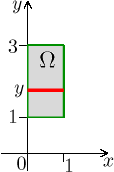
We can deduce from the picture that on every slice x changes between 0 and 1, we get

where y is taken as a constant. We then "add" these integrals using y, we get

We say that we set up a corresponding double integral for the given integral. We evaluate from inside, to emphasise this point we use parentheses to indicate the order, normally we do not do this.

When substituting into the inner integral we reminded ourselves what the working variable was at the time, that is, where should we substitute the integrating limits.
Summary: When we are given a double integral
![]()
we rewrite it as a repeated integral
![]()
(or in the other order). When evaluating, we start with calculating the inner integral
![]()
which gives raise to a function of variable x. Then we evaluate the outer integral
![]()
Now compare the two rewritten forms of the integral from the above example:

It looks as if we just switched the integrals and the corresponding differentials "d". However, it is this simple only when integrating over rectangles. In other cases, the so-called "change of order of integration" is a bit more complicated.
Example.
We will integrate the function
It always pays off to draw a picture of the region of integration,
it is a triangle with vertices
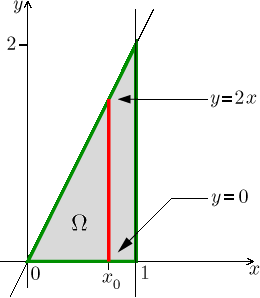
We see that we obtain a meaningful slice only by choosing x between 0 and 1, which tells us how the outside integral should go. The resulting repeated integral will therefore be of the form

On one particular slice, the variable y moves between the values

Now it is time to try horizontal slices.
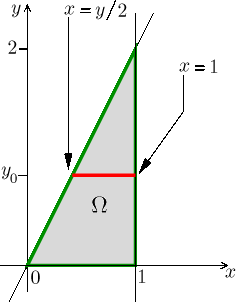
Location of a particular slice is determined by choosing y from the range
between 0 throught 2, this makes obvious how the outside integral will
go. The slice (on which x is the working variable) is a segment with its
right end at the level

We start with the inside integral

And we run into trouble right away, the antiderivative to
We see that our choice of the slicing direction, that is, our choice of the order of integration can have a big impact on the evaluation that follows. In less extreme cases it may influence the level of complexity of our calculations.
Although one of our attempts did not work out, it was still a useful exercise. Both ways of rewriting the integral were entirely correct and knowing how to set up an integral in this way is a basic knowledge. We also saw that when we changed the order of integration, the integrating limits did change.

This is typical, when changing the order, we have to rework the limits for integrals. Sometimes we are given a repeated integral and we are supposed to change the order of integration (one reason may be that we are not able to evaluate the integral as given). In such a case we first need to reconstruct the shape of the integrating region Ω using the known integrating limits (some sort of a reverse engineering), then we apply slices in the other direction to this region.
The two reworkings of the integral above show one more thing that beginners have to be careful about. When a repeated integral is set up properly, the following must be true (among other things): The outer integral has only numbers for its limits. The inner integral can take numbers or expressions with a variable for its limits, but this variable must be the outer one, the one that is last in the list of differentials.
An inquisitive reader has surely already thought of the fact that not all sets Ω fall into the two types we covered. In such a case it is usually possible to split this region into subregions that are of the right type, then we set up an integral for each of them. This is possible thanks to the linearity of integral with respect to the integrating region. Precise statement of what we mean is a bit more complicated in more dimensions, but roughly speaking is goes as follows:
Consider a region Ω
that we split into subregions
![]()
Example.
Let Ω be a region between
![]()
First we draw Ω and analyze our slicing options.
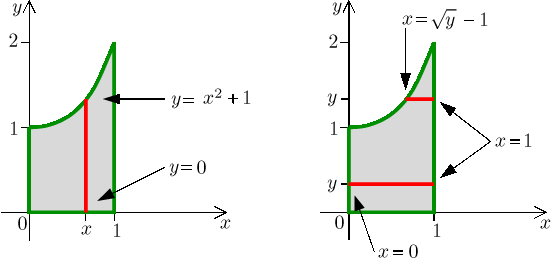
The shape of this set just calls for vertical slicing, where we first integrate with respect to y. Indeed, we see that if we tried slicing in the x-direction, then we would not get a universal formula for left endpoints of slices.
So we have the inner integral with variable y. We note that when
integrating the function

We get
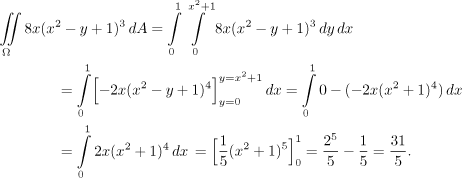
What if for some reason we do want slices in the x-direction? While all the
right endpoints of slices are given by the same formula
![]() .
We handle this complication easily by decomposing the region
Ω into its upper and
lower part, each of which has the right shape. In other words, we set up
two integrals.
.
We handle this complication easily by decomposing the region
Ω into its upper and
lower part, each of which has the right shape. In other words, we set up
two integrals.
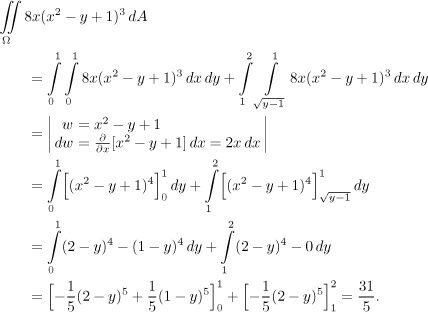
Whew, we got the same answer. I was apprehensive the whole time, fearing that I might be forced to search for a mistake in calculations.
And that's about it.
Remark.
If you are curious how to work out a triple integral
![]()
In this case Ω is a three-dimensional object. We need to add values of f at all points of this set, to do so we need to organize them using slicing.
If we fix one variable, say, x, then we obtain a cut through this object that is perpendicular to the x-axis, but only for values of x from some range a through b. In this way we get the first level of decomposition
![]()
Now we need to integrate over a typical slice, but that is a two-dimensional object in directions y and z, its particular shape depends on the choice of x. If we are lucky, it is a region of reasonable shape, meaning one of the two types we covered above.
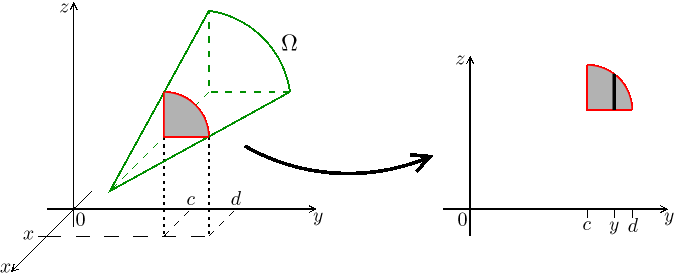
We know how to do double integrals, for instance, with a bit of luck the
slices (one-dimensional) in the y-direction might work. Those make sense
only for y taken between certain values
![]()
Of course, we do not know in general that exactly this particular order od slicing will work, there are six possible orders and depending on the shape of Ω at least one should do.
It is quite obvious that in order to be able to set up such an integral one needs a good spacial imagination and mastery of analytical treatment of geometrical shapes.
Remark.
What use can such "adding of values" be? Here is one example.
When we have n numbers
![]()
we need to add them for it.
If we have a function f on some interval
![]()
If we have a function
![]()
And if you have a function